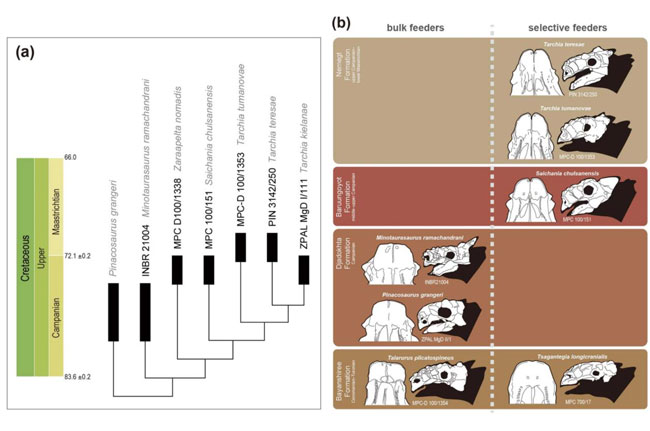Scientists have named a new species of armoured dinosaur based on cranial and postcranial fossils collected in 2008 from the famous Nemegt Formation of the Gobi Desert, Mongolia. A detailed analysis of the fossil material consisting of a well-preserved skull, vertebrae, ribs, part of the hip and a tail club has been published in the journal “Scientific Reports”. The new ankylosaur has been named Tarchia tumanovae and it is the third species to be assigned to the Tarchia genus.

Location map (a) of the fossil discovery in Mongolia with (b) a larger scale map showing the fossil quarry. Photograph (c) shows the specimen (MPC-D 100/1353) partially excavated with (d) a line drawing of the fossils in situ. T. tumanovae illustrations show known fossil bones in white (e) dorsal view, (f) left lateral view and (g) shows a skeletal reconstruction with dermal armour. Picture credit: Park et al.
Picture credit: Park et al
Evidence of Injury and a Damaged Tail Club
A joint Korean/Mongolian expedition discovered the fossil material at Hermiin Tsav in the southern Gobi Desert. The ribs show signs of fracture healing and there are localised injuries on the pelvic bones. The researchers speculate that these injuries were probably caused by intraspecific combat. The pathology is consistent with tail club strikes. Intriguingly, the tail club of the skeleton also shows signs of injury. The tail club is asymmetrical when viewed from above (dorsal view). A badly healed ossified tendon on the tail knob handle is present, a possible injury caused as the tail was used during combat. Whether this injury occurred as a result of intraspecific combat or when deterring an attack from a theropod is unknown.
Noting a Change in the Diet of Late Cretaceous Ankylosaurids
The scientists noted wide muzzles are a character of low-level, bulk feeders, whereas those ankylosaurines with narrower muzzles such as T. tumanovae and the coeval, closely related Tarchia teresae were probably selective feeders. The researchers demonstrate that ankylosaurid diets shifted from one of low-level, relatively unfussy bulk feeders during the early Campanian to more selective diets as characterised by a narrower muzzle by the late Campanian/early Maastrichtian.

Photographs (a–d) and line drawings (e–h) of the skull of Tarchia tumanovae sp. nov. (MPC-D 100/1353). Photographs of the skull in (a) left lateral, (b) right lateral, (c) anterior, and (d) occipital views. Line drawings in (e) left lateral, (f) right lateral, (g) anterior, and (h) occipital views.
Picture credit: Park et al
It is not known why ankylosaurids show this trend towards selective feeding, although the researchers speculate that this change could have been a consequence of habitat change as the region gradually became less arid towards the very end of the Cretaceous. The research team also postulate that ankylosaurids evolved more selective browsing habits in response to the presence of bulk-feeding saurolophine hadrosaurids such as Saurolophus angustirostris and Barsboldia sicinskii.

A diagram showing (a) a phylogenetic analysis of Tarchia tumanovae, placed in the context of geological time. Ankylosaurids from this region seem to have changed feeding strategies, (b), evolving narrower muzzles that indicate a switch from low-level bulk feeding to more selective browsing. Ankylosaurid fossils from the geologically older Bayanshiree and Djadokhta Formations which represent arid habitats had broad muzzles, whilst ankylosaurids from the younger and more humid Nemegt Formation have narrower muzzles. Picture credit: Park et al.
Picture credit: Park et al
Honouring a Famous Researcher
The species name honours Tat’yana A. Tumanova of the Russian Academy of Sciences, in recognition of her contribution to the study of Mongolian armoured dinosaurs.
The scientific paper: “A new ankylosaurid from the Upper Cretaceous Nemegt Formation of Mongolia and implications for paleoecology of armoured dinosaurs” by Jin-Young Park, Yuong-Nam Lee, Yoshitsugu Kobayashi, Louis L. Jacobs, Rinchen Barsbold, Hang-Jae Lee, Namsoo Kim, Kyo-Young Song and Michael J. Polcyn published in “Scientific Reports”.
The Everything Dinosaur website: Dinosaur Models: Dinosaur Models.






Leave A Comment